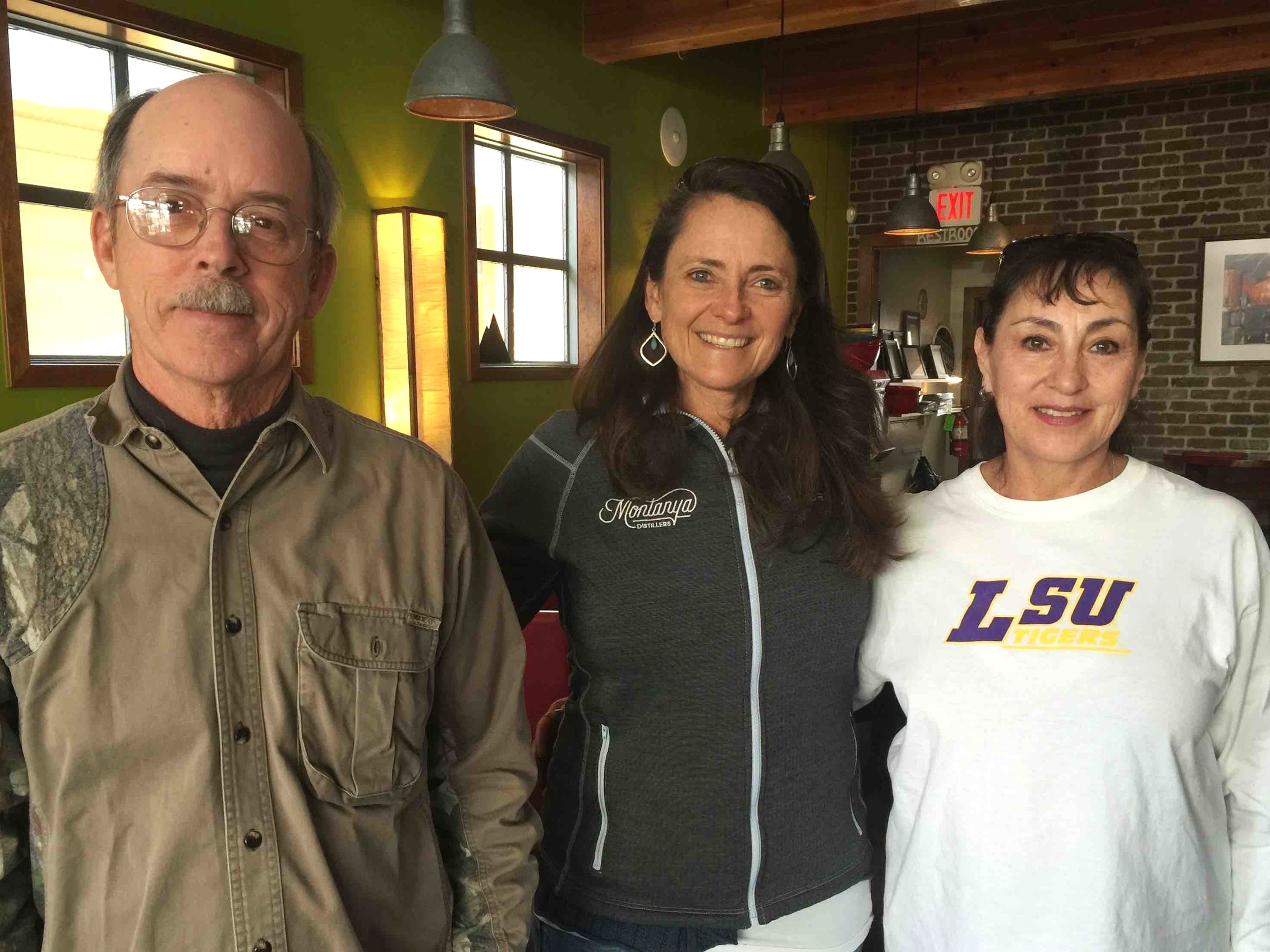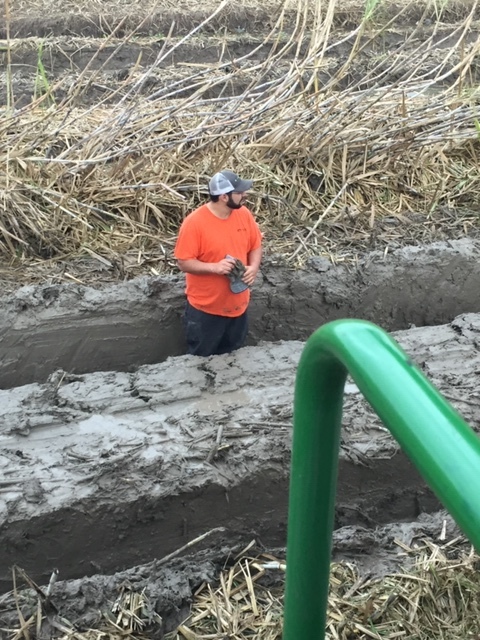Meet the Growers: Isabel and Will Thibaut
It’s always been important to us to source our sugar cane and molasses as close to home as possible. About five years ago, Montanya Distillers began searching for a new sugar cane supplier because our Hawaii producer wouldn’t certify that the products we were buying were USA grown. (Weird, right?) Imagine our delight when a sugar cane-growing family from Louisiana walked into the Tasting Room in Crested Butte and offered to put us in touch with their co-op of growing families associated with the Lula Sugar Mill in Belle Rose.
Will (left) and Isabel (right) Thibaut with Montanya Distillers founder and owner Karen Hoskin in the Tasting Room in Crested Butte.
And imagine our further delight when we learned that Isabel Thibaut (one of the growers who stopped in) was born and raised in the Gunnison Valley—exactly the kind of connection we love! Every summer, Isabel and her husband, Will, return to Gunnison and Crested Butte to visit family and take a break from the hot, humid weather of Louisiana. It’s a great chance for us to connect with them face to face, and in today’s post, we introduce them to you:
A CB Connection
As a very young girl, Isabel lived in Crested Butte with her family. We’re not just talking the era of dirt roads and mining, though both were present. In those days, there was so much snow during winter that the family had to go up to the second floor of the house to see if the sun was shining. Isabel’s mother hung the laundry from a second-story window, out over the snow, to dry. And whenever they left the house, they walked through a veritable tunnel of snow to reach the street.
In this photo of Crested Butte, taken while the mines were still active, snow obscures the windows of the first floor. Isabel and her family often had similar conditions during winter, when they had to look out the second floor window to see if the sun was shining. Image provided by the Crested Butte Mountain Heritage Museum.
Isabel’s dad worked in the mines, and when they closed, the family moved to Fort Collins, Colo. and then to Gunnison, about 30 miles south of Crested Butte. Isabel attended school in Gunnison from second grade through high school and eventually met her husband while working at the Blackstock Pharmacy.
Louisiana Roots
Will’s upbringing was no less rooted in a sense of place. He grew up in Louisiana, where he says his family has been “forever” and has grown sugar cane for “a long time” on three plantations of land. His father and his grandfather before him worked as field managers, as well as his brother, while Will worked as a hauler and now manages the land. His son also works in a mill. As Will says, “It’s what we do.”
As a very young boy, he lived with his family in the Madewood Plantation House, built for Colonel Thomas Pugh in 1846 and a manor house for the surrounding plantation. While they did move into a more modern home with features like air conditioning, the land and sugar cane were very much in his blood.
Finding Each Other
In the early seventies, Will took some time away from Louisiana and came to Gunnison to ski. At the time, a trailer at the Tall Texan RV park just north of town was only $100 a month, and a season ski pass was $125. He noticed Isabel at the pharmacy, and the rest, as he likes to say, is history. The couple married and moved to Louisiana.
For Isabel, moving from Gunnison to Louisiana was quite the change. The people were wonderful, she says, but the heat and the humidity were something else. Spring and fall were nice, but come July, August and September, it was (and still is) hard to be outside. The cooking was different, too, with the stews, rues and dishes like Jambalaya. She was used to the cooler temps and drier air of Colorado, not to mention meat and potatoes. The lifestyle stuck, however, and the couple has been growing sugar cane together for 40 years now.
Three generations of Thibauts on the Louisiana plantation.
Life as Sugar Cane Growers
Will worked as the hauler and managed the trucks while his brother worked as the field manager. Isabel was the “gopher,” sometimes making as many as three or four daily trips to Baton Rouge, about 55 miles away, on top of raising their son.
Now, a tenant grows the sugar cane that supplies Lula Sugar Mill while Will manages the bigger picture of the three plantations, and Isabel does the books. Will has set his sights on retiring, but figuring out what that looks like will be a bit of a process. The couple admits that sitting at home isn’t Will’s style. While Isabel may be content to stay busy managing the house and helping out with the grandbaby—the fifth generation on the land—her husband will need something else to keep him occupied. In the meantime, they do make it to Gunnison and CB every summer to visit and hope to return for the fall colors.
A Year Round and “Dark to Dark” Job
Wet weather and mud led to some deep ruts in the roads.
What most people don’t understand, Isabel and Will say, is that growing sugar cane involves an incredible amount of work. Planting begins around Labor Day using a portion of last year’s crop: the tops of existing stalks are cut and then laid in the ground. Much like bamboo, eyes at each joint grow into new stalks.
Once the cane is planted, harvest of the previous year’s crop begins—typically around October 1st. Weather depending, harvest runs 24-7 and ends around Christmas. A wet year like 2018, however, can push that into the first or second week of January. The harvest has to then be transported to the mill, or in the early days when the family ran its own mill, the client. (The family’s biggest client was once Bush’s Beans.)
The end of the harvest doesn’t mean that life gets quiet. From that point forward, repairs must be made to roads and fields. This is especially true after a year like 2018, when wet weather left deep ruts in the roads that had to be fixed. And this year, the tenants are working to change the drainage of the land.
All in all, it’s a “dark to dark” job, and not a 9 to 5 occupation. That was especially true when Will did the hauling. He’d be out the door at dawn, and if a truck needed repairs, might not return until 11 o’clock at night.
During wet conditions, mud builds up on the machinery tires, falling off in great big “donuts.”
And these days, there are uncertainties that come with the job, not the least of which is climate change. For the Thibauts, climate change isn’t a theory and neither is the idea that the ocean might someday reach their land. “Oceanfront property” Isabel calls it, and she isn’t making a joke. They already observe the effects on the land, including a 2,000-acre wood that hasn’t dried out in years. The wood has rotted out, becoming useless now, because there is so much standing water.
All About Family
Despite the hard work and despite the challenges, Isabel and Will don’t hesitate when it comes to why they’ve stayed committed through the long days and the many uncertainties. Over two hundred years, four generations of their family have worked the land and now a fifth is growing up there. It’s all about family.
You Might Also Like:
Did you know that even though rum is made from sugar cane, it comes out of the still sugar-free and carb-free? Learn more with this inside look at the “rum plant.” :)





